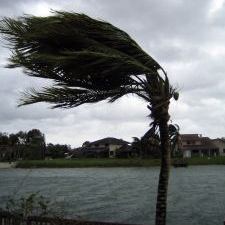 The Caribbean hurricane season, which generally runs from June 1 to November 30, with its peak from August to October, has thus far largely spared the U.S. from major damage, with the exception of Fay-related flooding in Florida.
The Caribbean hurricane season, which generally runs from June 1 to November 30, with its peak from August to October, has thus far largely spared the U.S. from major damage, with the exception of Fay-related flooding in Florida.
That may change. There’s a triple threat of tropical trouble headed our way, in the form of tropical storms (and probably soon-to-be hurricanes) Hanna, Ike and Josephine.
Find out the latest on how these storms are expected to affect travel and transportation over the next few days.
We’ll constantly add links, maps, photos, and other media to this page, so check back often, or jump right in and join our discussion …
Find the Latest on Ike’s Aftermath – See Update 5
The big question keeping forecasters guessing: Where Hanna is headed? On Monday, the National Hurricane Center (NHC) predicted landfall in northern Florida, which was battered by heavy rains from Tropical Storm Fay just a few weeks ago.
That’s since been revised a bit, with the NHC now saying that Hanna is most likely to brush northern Florida, before heading north and striking around Charleston, South Carolina on Friday morning. Link.
USA Today‘s “Cruise Log” blogger Gene Sloan reports that Hanna continues to scatter cruise ships plying the Caribbean. At this point, while some cruises have made changes to their itineraries (substituting Key West for the Bahamas, for example), none of them have canceled or were similarly severely affected. Link.
Meanwhile, most domestic airports are relatively delay-free, and those with delays don’t have them because of Gustav or Hanna. The obvious exception is New Orleans’ Louis Armstrong International, which reopened around 3:23 p.m. local time. Link.
Of course, as Hanna approaches land, more airports could be affected. To find out the latest on flights and airports, one good source so check out the FlightStat’s airport delays listings.
The real doozy for air traffic would be if Hanna veers a bit west from its projected course. That would push it toward Atlanta’s Hartsfield-Jackson International Airport, the nation’s busiest, which could have major ripple effects on the rest of the nation’s air traffic system.
And what is that projected course? The map from the National Oceanic and Atmospheric Administration shows Hanna’s projected course over the next few days …
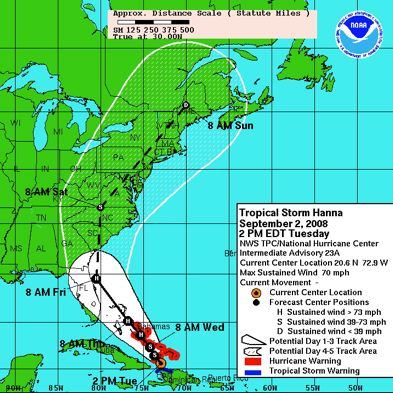
UPDATE 1
Hanna has veered northward a bit more and is now expected to come ashore somewhere in the Carolinas before traveling north along America’s East Coast. It’s a pattern similar to what’s known in weather circles as a nor’easter, or northeaster.
These storms generally aren’t known for their massive destructive force, but rather their ability to cause lots of precipitation, flooding and coastal erosion, as well as strong tides and rip currents.
Hanna’s revised course as projected by the National Hurricane Center is below:
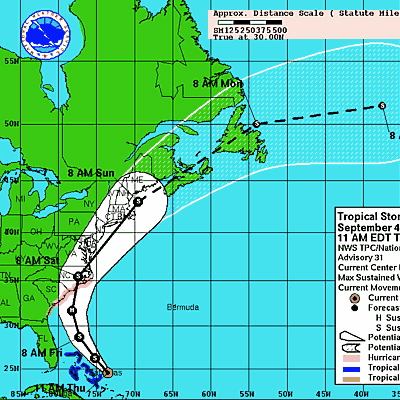
Meanwhile, further out in the Caribbean, it appears that Hurricane Ike may be far more nasty than either Hanna or Gustav. Already, Ike is up to a Category 4 storm, the second-strongest category of hurricane.
With Hanna projected to drench much of the East Coast, having the powerful Ike as a follow-up could be devastating. Currently, Ike looks to be the much more dangerous storm, although Hanna is certainly still a factor.
At this point, though, Ike’s course is still a bit of a mystery, although the National Hurricane Center has offered a projection:
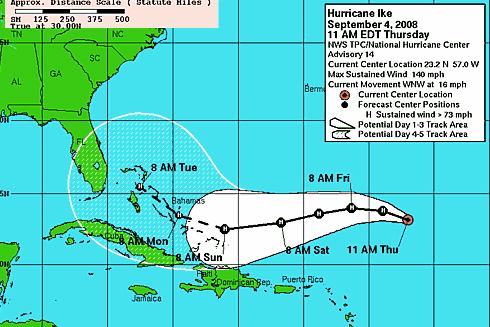
Helping Hurricane-Hit Haiti
While the US may have been largely spared thus far, Haiti was pummeled by Hurricane Gustav and Tropical Storm Hanna, killing at least 136 people and counting in just a two-week span. A third punch is expected from Hurricane Ike, which is currently rolling across the Caribbean.
Gustav dumped heavy rains on the island before Hanna passed over the northern coast, which caused massive flooding across the country. The Red Cross estimates that nearly 7,000 people are in emergency shelters as floods and landslides have destroyed or damaged homes and much of Haiti’s infrastructure.
To help provide emergency relief and support to Haiti, check out some of the following resources:
- American Red Cross, 1-800-HELP NOW, www.redcross.org.
- UNICEF, www.unicef.org
- PanAmerican Relief, www.panamericanrelief.org/
UPDATE 2
The Florida Keys may have dodged a bullet, as evacuation orders were lifted on Monday and residents began to return. But the ferocious Hurricane Ike did blast the island of Cuba. It made landfall in eastern Cuba, passing over the island and heading back into the ocean on the other side. This destructive jaunt did weaken Ike modestly, as it dropped to a Category 2 storm after reaching as high as category 4 (the second-strongest storm on the 5-point Saffir-Simpson scale).
Ike is projected to pass back over the western part of the island near Havana, threatening Cuba’s capital with massive winds and flooding. Forecasters aren’t quite sure yet where Ike is headed next, other than into the warm, hurricane-inducing waters of the Gulf of Mexico.
The tentative five-day projection from the National Hurricane Center indicates that Ike may cut a path straight through the Gulf and make landfall somewhere near Galveston, Texas. Of course, Ike has been known to make some course changes before, and forecasters are nowhere near certain where it might hit once it reaches the warm, open waters of the Gulf of Mexico.
Another big question mark is Ike’s strength. It declined after striking Cuba, and is likely to weaken further after making a repeat hit. The question is whether it can regain strength before crashing into land once again. If it does, the Gulf Coast could be in for a bad week.
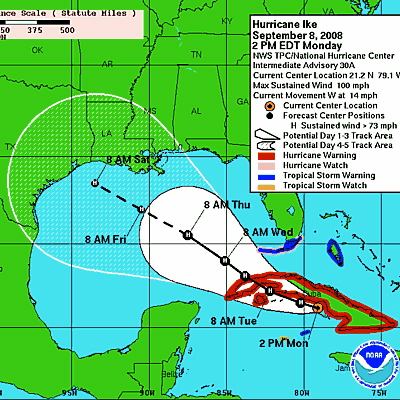
Meanwhile, in the middle of the Atlantic, tropical storm Josephine began to break apart and weaken significantly. Thankfully for the Caribbean’s storm-battered inhabitants, this removes the only other significant post-Ike weather threat for the time being.
UPDATE 3
Ike has slammed Cuba, roaring across the island not once but twice. Some of the country’s most historic buildings in Havana were heavily damaged, and a few even collapsed. So far, the number of deaths in Cuba is still unclear, but
Now, Ike has entered the warm water of the Gulf of Mexico and appears to be rapidly regaining strength. A number of forecasters have warned that it could reach up to Category 3 or possibly even a Category 4 hurricane before it reaches the Texas coast.
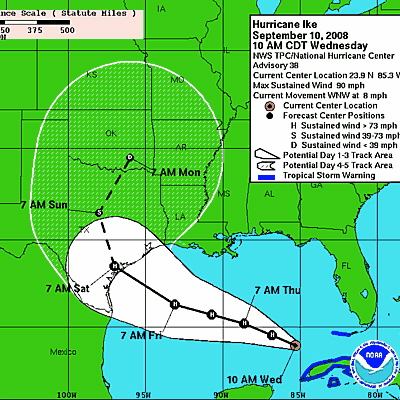
UPDATE 4 – IKE PREPARES STRIKE
Less than 24 hours before it’s scheduled to slam into the Texas coast, Hurricane Ike has reached maximum sustained wind speeds of 105 MPH, making it a Category 2 storm.
Many forecasters predict it could reach Category 3 strength, with maximum wind speeds of 111 MPH, by the time it makes landfall in early hours of Saturday morning.
According to the National Hurricane Center, Ike will make landfall just southwest of the Houston area in the small port town of Freeport. While this might seem like a good thing that Houston will avoid a direct hit, it’s actually one of the worst scenarios.
Why? Because with the way Ike is rotating, its strongest part is the northeast patch that will hover over Houston. This area of the storm will have the biggest storm surges and the highest levels of wind, which may maximize the damage to the Houston area.
Already, it appears that Galveston, essentially a barrier island with well over 50,000 people living on it, will be completely swamped. The city’s seawall (which only protects the most populated parts of the island) is only 17 feet high while storm surges are predicted to reach 20 to 25 feet.
Galveston Bay, which sits between Galveston and Houston, is already getting quite stormy, and as Ike approaches, it’s expected to also send storm surges rolling inland. In other bad news, the Houston area is home to about one quarter of the country’s oil and gas refineries. Most, like the Exxon facility in Baytown, have already been evacuated and shut down. If the area takes sustained damage, it could send gas prices surging.
Check out our new, and constantly-updated map of the effects as Hurricane Ike comes ashore in the Houston area…
UPDATE 5 – IKE’S AFTERMATH
Almost two weeks after Ike made landfall, some parts of the Houston metro area remain without power. While local energy provider Centerpoint has made progress restoring power, a large number of neighborhoods still have yet to see Centerpoint crews.
The port city of Galveston remains devastated with some experts predicting it could be weeks or even months before the city is made habitable again. Galveston, which sits on barrier island in the Gulf of Mexico, sustained the most damage of any area of Houston.
Following the storm, it was discovered that thousands of residents had ridden out the storm in the city. But despite having survived Ike, many residents began to flee the area once the extent of the damage became apparent. Only in the past day or two have residents begun returning in significant numbers.
City services, including power, water, gas, sanitation and even medical care, remain scarce in Galveston and many homes and businesses still show signs of significant damage. Mosquitos, snakes and rats remain a serious health risk, and Galveston residents have been warned to get tetanus booster shots before returning home.
Despite this, city leaders remain optimistic that they can get the city up and running again in time to host an annual motorcycle festival at the end of October.
Progress is being made. While a boil order remains in effect for Galveston, water service is being restored in some areas. City Hall, damaged in the hurricane, is going to partially reopen on Monday. Regular household trash collection will also begin Monday, even as debris removal continues from city streets. Businesses are beginning to reopen and power has even been restored in many parts of Galveston, though many individuals and businesses are unable to use it due to fuse boxes and power lines that were flooded and shorted out.
Wondering if you should get travel insurance in cases like this? Check out our answer to the question: Should I Purchase Travel Insurance?
And if you’re just thinking “why would anyone want to travel there during hurricane season?” then we’ve got the article for you: Hurricane Guarantees and “Hurricane-Free” Islands.
Join our hurricane and severe weather discussion below …












